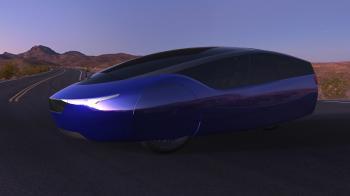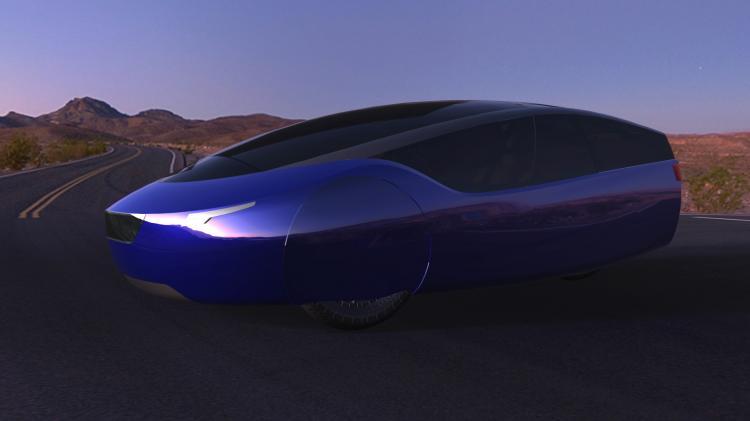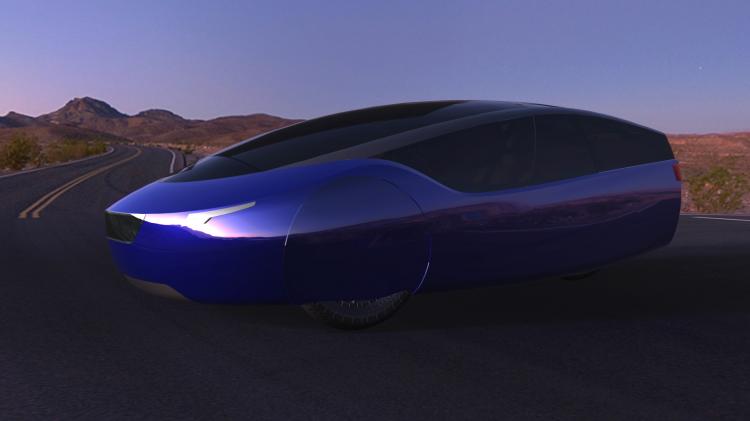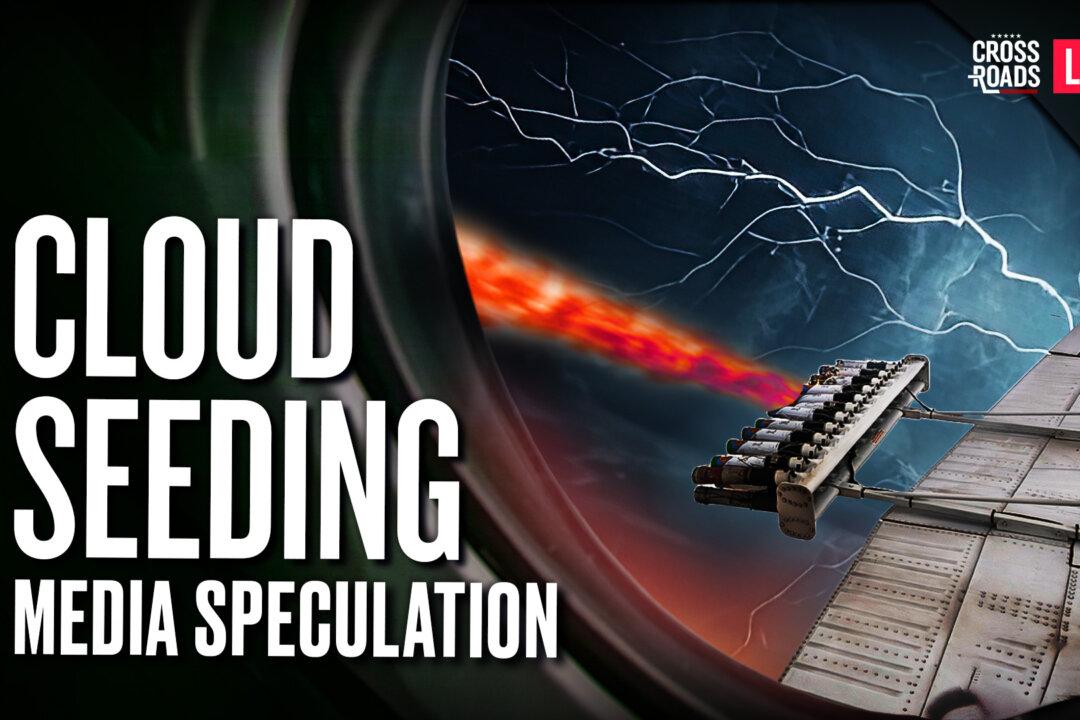[youtube]t-BqiOOygFw[/youtube] Urbee Car Model - Sneak PeakJim Kor wanted to create the perfect car. What started as a dream would later become a Web sensation that would open new doors of innovation to the world.
The Urbee has become the first prototype car with an exterior built completely with a 3-D printer. Although still in development, the three-wheeled futuristic car that gets 200 miles per gallon is the first from Kor Ecologic. Kor founded the company with a group of like-minded engineers and friends who volunteer their time to do something they believe can benefit the world.
“Rather than saying what would somebody buy, we started from a point of what kind of car do we need to preserve nature and get off oil,” said Blaine McFarlane, Kor Ecologic mechanical engineer. “It wasn’t centered around marketing, it was centered around energy 100 percent.”
Aside from its fuel efficiency, crowds have flocked to the Urbee concept because it has pioneered new realms of 3-D printing. All the panels on the car were created using a large 3-D printer that can carve out physical objects from a digital, 3-D model.
According to McFarlane, he and the team didn’t think much of it. It was more of a default decision that came about while inquiring about how to build the car.
They were given a digital, 3-D model of the car by a sponsor who had scanned a clay concept design, but getting a concept from a computer model to a finished prototype is a long process. It normally requires fiberglass work and customized parts that can run a check through the roof, and “it’s a huge amount of work, especially when you have a very small budget,” McFarlane said.
For a finished car, 3-D printing likely wouldn’t be feasible since the process is somewhat slow “but in a prototype, the cost is very, very competitive, especially when it comes to the time it would normally take to make patterns, molds, and hand-form parts,” he said. “This process is much, much faster.”
The idea came from an e-mail conversation between McFarlane and Nino Caldarola, who is known for creating a 3-D printed aircraft engine at Autodesk University 2009, an annual conference on 3-D software and its possibilities.
“It just started to evolve from there and we started thinking ‘well, maybe we can just print the body.’ That’s really what we ended up doing,” McFarlane said.
He added “just being able to design something with a laptop and send the files away and get a car back is pretty exciting.”
The electric-ethanol hybrid is one of a kind. Although still in the process of being completed, it has an organic, long, yet rounded shape with a large glass cover stretching the length of the hood and top.
“I think when you design based on basic principles you tend to get these organic shapes that mimic nature, and people can find those shapes very attractive,” McFarlane said, adding, “The whole design is not just based on aerodynamics, but anything related to energy.”
The Urbee has become the first prototype car with an exterior built completely with a 3-D printer. Although still in development, the three-wheeled futuristic car that gets 200 miles per gallon is the first from Kor Ecologic. Kor founded the company with a group of like-minded engineers and friends who volunteer their time to do something they believe can benefit the world.
“Rather than saying what would somebody buy, we started from a point of what kind of car do we need to preserve nature and get off oil,” said Blaine McFarlane, Kor Ecologic mechanical engineer. “It wasn’t centered around marketing, it was centered around energy 100 percent.”
Aside from its fuel efficiency, crowds have flocked to the Urbee concept because it has pioneered new realms of 3-D printing. All the panels on the car were created using a large 3-D printer that can carve out physical objects from a digital, 3-D model.
According to McFarlane, he and the team didn’t think much of it. It was more of a default decision that came about while inquiring about how to build the car.
They were given a digital, 3-D model of the car by a sponsor who had scanned a clay concept design, but getting a concept from a computer model to a finished prototype is a long process. It normally requires fiberglass work and customized parts that can run a check through the roof, and “it’s a huge amount of work, especially when you have a very small budget,” McFarlane said.
For a finished car, 3-D printing likely wouldn’t be feasible since the process is somewhat slow “but in a prototype, the cost is very, very competitive, especially when it comes to the time it would normally take to make patterns, molds, and hand-form parts,” he said. “This process is much, much faster.”
The idea came from an e-mail conversation between McFarlane and Nino Caldarola, who is known for creating a 3-D printed aircraft engine at Autodesk University 2009, an annual conference on 3-D software and its possibilities.
“It just started to evolve from there and we started thinking ‘well, maybe we can just print the body.’ That’s really what we ended up doing,” McFarlane said.
He added “just being able to design something with a laptop and send the files away and get a car back is pretty exciting.”
The electric-ethanol hybrid is one of a kind. Although still in the process of being completed, it has an organic, long, yet rounded shape with a large glass cover stretching the length of the hood and top.
“I think when you design based on basic principles you tend to get these organic shapes that mimic nature, and people can find those shapes very attractive,” McFarlane said, adding, “The whole design is not just based on aerodynamics, but anything related to energy.”
The concept behind the Urbee is that it should use a sustainable amount of fuel—just what could be gathered and grown in a typical city lot, according to McFarlane. If someone were to place a solar panel on their garage and plant a garden for their ethanol fuel, that should be enough to power the Urbee.
Having a 3-D model of the car makes the design process much faster. Since the team at Kor Ecologic work in engineering, they are well versed in 3-D CAD modeling. Using various forms of software they’re able to run digital tests on the car and fine-tune it before building it.
“Historically you would need to buy the car, put it in a wind tunnel—or at least build a model of the car—but these tools are just phenomenal from that standpoint,” McFarlane said. “Once you build it you’re basically just validating what the computer told you you’re going to see.”
The Urbee car could hit the market within the next three years, if all goes well.
Having a 3-D model of the car makes the design process much faster. Since the team at Kor Ecologic work in engineering, they are well versed in 3-D CAD modeling. Using various forms of software they’re able to run digital tests on the car and fine-tune it before building it.
“Historically you would need to buy the car, put it in a wind tunnel—or at least build a model of the car—but these tools are just phenomenal from that standpoint,” McFarlane said. “Once you build it you’re basically just validating what the computer told you you’re going to see.”
The Urbee car could hit the market within the next three years, if all goes well.







